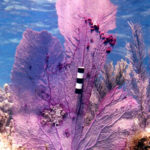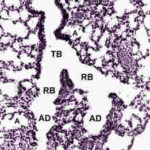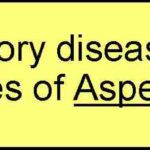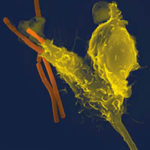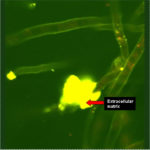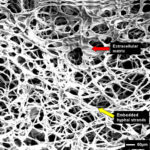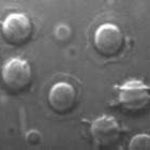Date: 26 November 2013
Secondary metabolites, structure diagram: Trivial name – Asterriquinone B4
Copyright: n/a
Notes:
Species: A. terreusSystematic name: 2,5-Cyclohexadiene-1,4-dione, 2,5-bis[2-(1,1-dimethyl-2-propenyl)-1H-indol-3-yl]-3,6-dimethoxy-Molecular formulae: C34H34N2O4Molecular weight: 534Chemical abstracts number: 78723-17-8Selected references: Arai, Kunizo; Masuda, Kikuo; Kiriyama, Noriki; Nitta, Keiichi; Yamamoto, Yuzuru; Shimizu, Sakae (Fac. Pharm. Sci., Kanazawa Univ., Kanazawa 920, Japan). Chem. Pharm. Bull., 29(4), 961-9 (English) 1981.
Images library
-
Title
Legend
-
Aspergillosis in the coral sea fan Gorgonia ventalina. Sea fan coral Gorgonia ventalina, Florida Keys, USA. Depth ~5 metres, showing a lesion surrounded by a band of purple tissue. Central areas of the lesion are devoid of coral tissue revealing the underlying axial skeleton. The purple areas are devoid of coral polyps and result from the increased production of purple sclerites (small, non-fused, carbonate skeletal elements). The purpled area also indicates the location of high fungal hyphal density and el
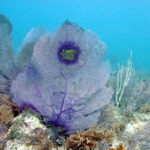
-
Aspergillosis in the coral sea fan Gorgonia ventalina. In the Caribbean ond offshore USA the sea fan coral species Gorgonia ventalina is undergoing an epizootic due to Aspergillus sydowii infection. This species of Aspergillus is also known to be associated with food contamination and for opportunistic infection in humans.Taken in San Salvador, Bahamas. Bar represents 5cm. This sea fan was heavily colonized by algae.A -tumours and galls B -lesion C -purplingGalls are composed of axial skeleton and scl
